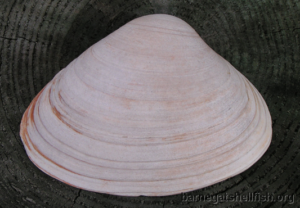
There are many species of clams living in the ocean near Barnegat Bay.
Surf Clams and Ocean Quahogs
Atlantic Surf Clam Spisula solidissim
 The Atlantic Surf Clam is the largest clam on the Atlantic coast.
The Atlantic Surf Clam is the largest clam on the Atlantic coast.
They are not typically found in Barnegat Bay but are abundant in the ocean waters off of Island Beach and Long Beach Island.
Surf clams range from near shore to a depth of about 200 feet, but their abundance is low in waters deeper than about 130 feet.
Surf clams reach harvestable size in about six years. They can reach up to 8 inches, but clams larger than 7 inches are rare.
Adult clams prefer to live in fine to medium grained sandy sediment. This may be in a nearshore location or in open waters that have suitable sandy bottoms, to the 130 foot depth.
Adult surf clams dig into the sandy bottom and normally stay in one location.
The ocean, especially near the beach, is much more turbulent than the bay.
Storms, waves and strong currents can move them around but they can establish themselves in a new location if the bottom conditions are right.
If they can’t dig in, they become vulnerable to predators.
- They grow up to 8.9 inches, although Surf clams are the largest bivalve found in the western North Atlantic.
- Clams larger than 7.9 inches are rare.
- Their shells are thick, triangular, and yellowish-white with rounded edges and concentric ridges
- Surf clams are fast growing, maturing in five to seven years
- Surf clams grow more slowly in warmer waters
- They live longer in deeper water
Surf clams can live up to 35 years
Surf clams are generally processed for human consumption in soups, chowders, and stews; while a small portion of landings are also sold in the bait market
Surf clams account for the majority of all clams commercially harvested in the United States.
They are sold chopped and canned, and are eaten in sauces and chowders.
Fishermen also use surf clam as bait for stripped bass and other fish.
Fun Fact – Surf clams are tumbled in the onshore waves and their shells are broken, providing food for stripped bass and other fish near the shoreline.
One reason surf fishermen use clams for bait.
Ocean Quahog Arctica Islandica
 The ocean quahog is a species of edible clam, a marine bivalve mollusk in the family Arcticidae.
The ocean quahog is a species of edible clam, a marine bivalve mollusk in the family Arcticidae.
This species is native to the North Atlantic Ocean, and it is harvested commercially as a food source.
The typical Arctica islandica resembles the hard clam, but the shell of the ocean quahog is rounder, the periostracum is usually black.
Unlike the hard clam, which lives intertidally and can be collected by clam digging, this species lives subtidally, and can only be collected by dredging.
Adult ocean quahogs are usually found in dense beds over level bottoms, just below the surface of the sediment which ranges from medium to fine grain sand
Ocean quahogs are known by a number of different common names, including mahogany clam and black clam
Arctica islandica’s extreme longevity arises from a lowered somatic maintenance costs and a low aging acceleration.
It takes an average of 5.8 years to reach maturity
For individuals in populations in cold areas the growth rate is probably further slowed because growth only occurs in summer.
Ocean quahogs can live for over 100 years. One example of longevity is a clam nicknamed “Ming” that was proven to be 507 years old.
Like other clam species, ocean quahog is a filter feeder.
Feeding activity appears regulated by light levels, which can be used as a proxy for food availability.
This means that at the northern extreme of the distribution, feeding is concentrated during eight months of the year, while during the rest of the year the clams only feed for a few days a month.
